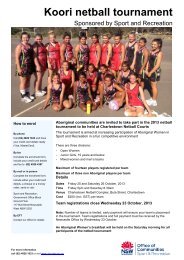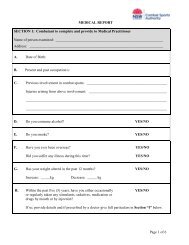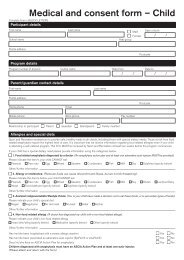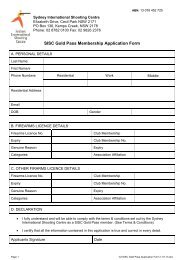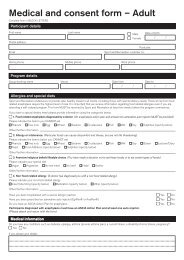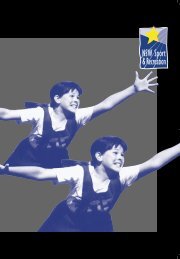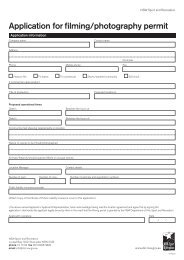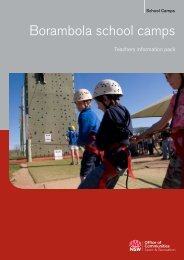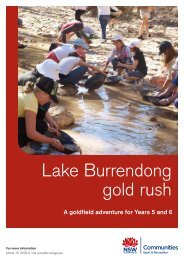Sport and Recreation Program Development and Delivery: Stages 1
Sport and Recreation Program Development and Delivery: Stages 1
Sport and Recreation Program Development and Delivery: Stages 1
- No tags were found...
You also want an ePaper? Increase the reach of your titles
YUMPU automatically turns print PDFs into web optimized ePapers that Google loves.
<strong>Sport</strong> <strong>and</strong> <strong>Recreation</strong> <strong>Program</strong>sOutdoor education can support student outcomes such aspersonal <strong>and</strong> group development, a positive school culture<strong>and</strong> general capabilities at a deeper <strong>and</strong> more thorough levelthan other disciplines (Martin & Hewison 2009).The highest priority for <strong>Sport</strong> <strong>and</strong> <strong>Recreation</strong> Centres is tosupport the development of school aged children throughoutdoor experiential education <strong>and</strong> recreation programs.<strong>Program</strong>s have been developed to take advantage ofunique learning environments, encourage <strong>and</strong> supportstudents undertaking personal challenge, support positiveengagement within the camp community <strong>and</strong> connectionwith the natural environment.<strong>Program</strong> development <strong>and</strong> delivery is focussed on workingwith schools to help them meet the objectives they haveidentified for their students.All programs include the core components:• individuals taking personal responsibility• working as a team <strong>and</strong> contributing to common outcomes• valuing others <strong>and</strong> accepting differences• appreciating the natural environment.Three broad program themes are available to meet generaloutcome requirements. Each can be tailored to meet specificschool needs. <strong>Program</strong> Coordinators liaise with school toidentify specific issues relevant within the school community<strong>and</strong> support current school curriculum to enhance <strong>and</strong>customise programs.<strong>Recreation</strong> <strong>Program</strong>s<strong>Recreation</strong> programs provide an introduction to outdoorphysical recreation activities while incorporating the corevalues of <strong>Sport</strong> <strong>and</strong> <strong>Recreation</strong>.<strong>Recreation</strong> programs are designed to:• encourage students to participate in a range of activities• learn new skills• encourage continued participation in physical recreation• compliment school based physical recreation programs• promote fun <strong>and</strong> enjoyment• provide personal challenge.Personal <strong>and</strong> Social <strong>Development</strong> <strong>Program</strong>sPersonal <strong>and</strong> Social <strong>Development</strong> programs provide anopportunity to deliver syllabus outcomes <strong>and</strong> personal growthwhile incorporating the core values of <strong>Sport</strong> <strong>and</strong> <strong>Recreation</strong>.Personal <strong>and</strong> Social <strong>Development</strong> programs are designed to:• enable staff to work closely with students to addressissues on an intimate level• align with PDHPE <strong>and</strong> HSIE curriculum objectives• encourage positive relationships between teachers <strong>and</strong>students, benefiting the overall school culture• create atmosphere of underst<strong>and</strong>ing <strong>and</strong>shared reflection• support student learning needs in an encouraging <strong>and</strong>supportive environment• identify barriers to be faced by students <strong>and</strong> developskills to manage <strong>and</strong> overcome barriers• encourage interaction between students.Natural Environment <strong>and</strong> Heritage <strong>Program</strong>sNatural Environment <strong>and</strong> Heritage programs provide anopportunity for better awareness <strong>and</strong> appreciation of thenatural environment <strong>and</strong> heritage while incorporating thecore values of <strong>Sport</strong> <strong>and</strong> <strong>Recreation</strong>.Natural Environment <strong>and</strong> Heritage programs are designed to:• promote learning by interacting with the environment inan intimate manner• enable first h<strong>and</strong> experience in marine, bushl<strong>and</strong> oralpine environments.• promote better underst<strong>and</strong>ing of Indigenous heritageby site visits• promote the use of the experiential learning with theenvironment a key learning tool• enable the natural environment to complement <strong>and</strong>enhance classroom learning• encourage individuals to better underst<strong>and</strong> theirresponsibility to the environment <strong>and</strong> future generations• assist individuals to develop a connection <strong>and</strong>appreciation for the natural world• increase knowledge <strong>and</strong> underst<strong>and</strong>ing of therelationship between past <strong>and</strong> present cultural heritage• promote the conservation of Centres <strong>and</strong> theirenvironment for the future• promote the notion of sharing culture, values <strong>and</strong> attitudes.<strong>Sport</strong> <strong>and</strong> <strong>Recreation</strong> <strong>Program</strong> <strong>Development</strong> <strong>and</strong> <strong>Delivery</strong>: <strong>Stages</strong> 1, 2 <strong>and</strong> 3 | 7 |



